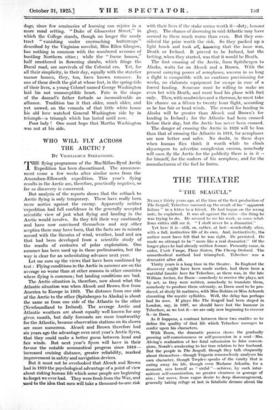WHO WILL FLY ACROSS THE ARCTIC ?
BY VILIIJALMUR STEFANSSON. THE flying programme of the MacMillan-Byrd Arctic Expedition has been discontinued. The announce- ment came a few weeks after similar news from the Amundsen-Ellsworth expedition. This year's flying results in the Arctic are, therefore, practically negative, so far as discovery is concerned.
But analysis of the reports shows that the setback to Arctic flying is only temporary. These have really been mere sorties against the enemy. Apparently neither 'expedition had full confidence in the generally accepted scientific view of just what flying and landing in the Arctic 'would involve. So they felt their way cautiously and have now convinced themselves and any . other sceptics there may have been, that the facts are in minute accord with the theories of wind, weather, land and sea that had been developed from a scientific study of the results of centuries of polar exploration. One summer has been used up in these preliminaries, but the way is clear for an unhesitating advance next year.
Let me sum up the views that have been confirmed by test : Flying conditions in the Arctic in summer are on the average no worse than at other seasons in other countries where flying is common ; but landing conditions are bad.
The Arctic situation is, therefore, now about what the Atlantic situation was when Alcock and Brown flew from America to Europe in 1919. The distance from one side of the Arctic to the other (Spitsbergen to Alaska) is about the same as from one side of the Atlantic to the other (Newfoundland to Ireland). The average Arctic and Atlantic weathers are about equally well known for any given month, but daily forecasts are more trustworthy for the Atlantic, because observation stations on its shores are more numerous. Alcock and Brown therefore had six years ago the advantage over next year's Arctic flyers, that they could make a better guess between head and fair winds. But next year's flyers will have in their favour the notable aeronautical progress since 1919— increased cruising distance, greater reliability, marked improvement in safety and navigation devices.
But it must not be overlooked that Alcock and Brown had in 1919 the psychological advantage of a point of view about risking human life which some people are beginning to forget we ever had. They were fresh from the War, and used to the idea that men will_take a thousand-to-one risk with their lives if the stake seems worth it—duty, honour glory. The chance of drowning in mid-Atlantic may have seemed to them much worse than even. But they con- sidered the prize worth the risk. So they packed up a - light lunch and took off, knowing that the issue was, Death or Ireland. It proved to be Ireland, but the betting, when they started, was that it would be Death.
The first crossing of the Arctic, from Spitsbergen to Alaska, waits for an Alcock and a Brown. With the present carrying power of aeroplanes, success in so long a flight is compatible with no cautious provisioning for weeks, no elaborate equipment for escape in case of a forced landing. Someone must be willing to make an even bet with Death, and must load his plane with fuel only. Then, with sandwiches and a thermos, he must take his chance on a fifteen to twenty hour flight, according as he has fair or head winds. The reward for landing in Alaska will be greater than Alcock and Brown's for landing in Ireland ; for the Atlantic had been crossed before their day, but the Arctic has never been crossed.
The danger of crossing the Arctic in 1926 will be less than that of crossing the Atlantic in 1919, for aeroplanes are now better and safer. No doubt, in these days when human flies think it worth while to climb skyscrapers to advertise complexion creams, somebody will soon fly the Arctic for the publicity there is in it— for himself, for the makers of his aeroplane, and for the manufacturers of the fuel he burns.






























































 Previous page
Previous page